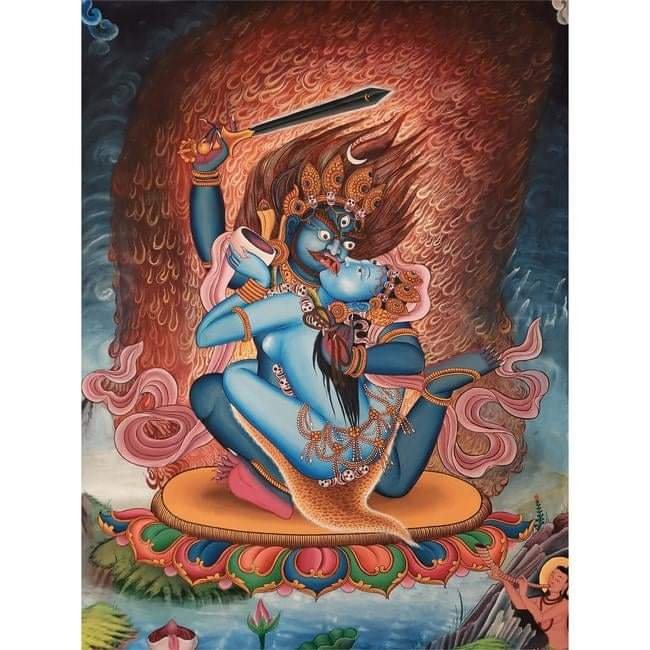Caṇḍamahāroṣaṇatantra: Unveiling the Essence
The Sanskrit term Caṇḍamahāroṣaṇatantra holds profound significance in the realms of Buddhism, Pali, Hinduism, and Sanskrit. Transliterated as Candamaharosanatantra, it encapsulates a rich tapestry of meaning, history, and spiritual significance.
1. Etymology:
Caṇḍamahāroṣaṇatantra:
Caṇḍa: Refers to fierce, intense, or wrathful aspects in spiritual contexts.
Mahā: Signifying greatness or vastness.
Roṣaṇa: Conveys the essence of passion, anger, or fervor.
Tantra: Implies a sacred text or scripture, often associated with spiritual practices.
2. Meaning and Spiritual Significance:
The term suggests a tantric scripture emphasizing intense and transformative practices.
"Caṇḍa" alludes to the ferocious aspects of divine forces, often employed for spiritual awakening.
"Mahā" underscores the magnitude of the transformative experiences sought through the teachings.
"Roṣaṇa" implies the fiery nature of emotions involved in the spiritual journey.
3. Historical Context:
Rooted in ancient Sanskrit and tantric traditions, the Candamaharosanatantra likely has historical ties to esoteric practices.
Exploration of this text may reveal insights into the evolution of tantric philosophy and rituals within Hinduism and Buddhism.
4. Buddhism and Pali Influence:
Given its mention in Buddhist and Pali contexts, the Candamaharosanatantra may offer a unique fusion of tantric elements with Buddhist philosophy.
The integration of wrathful deities and transformative practices aligns with certain Vajrayana Buddhist traditions.
5. English Translation:
While a precise English translation may vary, the term broadly suggests a "Tantra of Fierce Magnitude and Passionate Transformation."
6. Scholarly Contributions:
Scholars and practitioners alike may contribute to a deeper understanding by referencing relevant texts, cross-cultural influences, and comparative analyses.
In conclusion, the Caṇḍamahāroṣaṇatantra stands as a captivating intersection of spirituality, tantra, and transformative practices, inviting exploration and contemplation within the rich tapestry of Sanskrit traditions.
Exploring the Wisdom of Lord Vajrasattva and the Vajra Realm
The sacred text unveils a profound discourse as Lord Vajrasattva resides within the bhaga of the goddess of the Vajra Realm, embodying the essence of tathāgatas' body, speech, and mind. The assembly includes numerous vajra yogins and yoginīs, each representing distinct attributes.
1. Absorption and Utter Devotion:
Lord Vajrasattva, immersed in the absorption of Black Acala, speaks of liberation from duality, emphasizing devotion to the four joys.
Profoundly transcending mental constructs, he manifests in five forms to guide those unaware of his omnipresence in every being.
2. Goddess of the Vajra Realm:
The blessed goddess, absorbed in Hatred Vajrī, embodies emptiness and compassion, dwelling in divine pleasure devoid of mental constructs.
Her five forms serve to enlighten women about her pervasive presence in every female form.
3. Divine Union and Teachings:
Black Acala passionately engages with Hatred Vajrī, symbolizing a divine union of profound enjoyment and secret wisdom.
The Lord emphasizes the rarity and supreme nature of this knowledge, considered more essential than the essence itself, echoing teachings of all buddhas.
4. Themes and Symbolism:
The discourse explores themes of emptiness, compassion, and the transcendence of mental constructs.
Symbolic acts like kissing and embracing convey deeper spiritual truths, highlighting the intimate connection between the divine and the practitioner.
5. Yogic Assembly:
The multitude of vajra yogins and yoginīs signifies a diverse spiritual community, each contributing to the collective wisdom and practices.
6. Call for Further Exploration:
This passage invites a comprehensive exploration of tantric practices, emphasizing the transformative potential of union, devotion, and the transcendence of dualities.
In essence, the teachings of Lord Vajrasattva and the goddess of the Vajra Realm delve into the profound realms of tantric wisdom, offering practitioners a path of liberation, devotion, and union with the divine, symbolized by the intricate dance of Black Acala and Hatred Vajrī.



